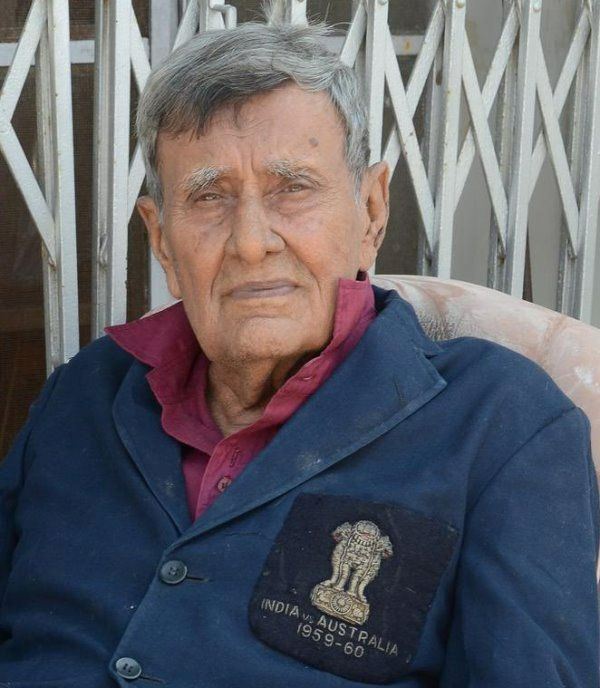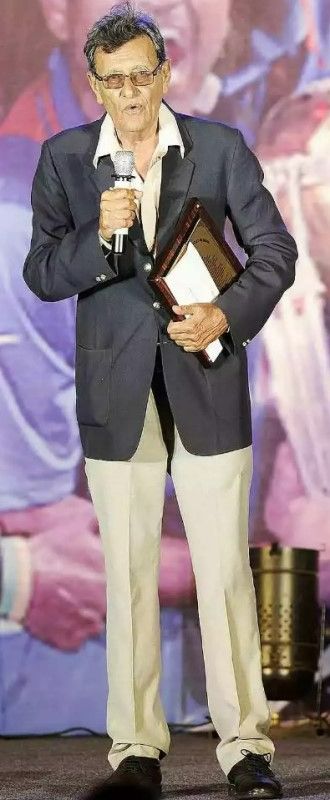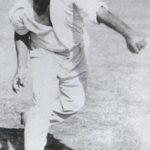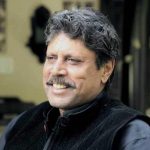Salim Durani Height, Age, Death, Wife, Family, Biography & More
| Bio/Wiki | |
|---|---|
| Full name | Salim Aziz Durani [1]The Wire |
| Nickname(s) | Prince Salim [2]The Times of India and Shahzada Salim [3]The Times of India |
| Profession | Former Indian Cricketer (all-rounder) |
| Famous for | The first cricketer to win an Arjuna Award. |
| Physical Stats & More | |
| Height (approx.) | in centimeters- 185 cm in meters- 1.8 m in feet & inches- 6’ 2” |
| Weight (approx.) | in kilograms- 55 kg in pounds- 120 lbs |
| Eye Colour | Blue |
| Hair Colour | Salt and pepper |
| Cricket | |
| International Debut | Test- On 1 January 1960 against Australia at Mumbai |
| Last Match | Test- On 6 February 1973 against England at Mumbai |
| Domestic/State Team | • Saurashtra • Gujarat • Rajasthan • Central Zone |
| Coach/Mentor | Vinoo Mankad |
| Batting Style | Left-handed |
| Bowling Style | Left-arm orthodox spin |
| Awards | • 1961: Arjuna Award • 2011: CK Nayudu Award for lifetime achievement |
| Acting | |
| Debut | Film (Hindi): Ek Masoom (1969) as Deepak/Ramesh |
| Personal Life | |
| Date of Birth | 11 December 1934 (Tuesday) |
| Birthplace | He was born in Afghanistan. |
| Date of Death | 2 April 2023 |
| Place of Death | Jamnagar, Gujarat, India |
| Age (at the time of death) | 88 Years |
| Death Cause | Cancer [4]Mathrubhumi |
| Zodiac sign | Sagittarius |
| Signature/Autograph |  |
| Nationality | Indian |
| Religion | Islam |
| Caste | Pathan [5]The Wire |
| Relationships & More | |
| Marital Status | Married [6]Rediff |
| Family | |
| Parents | Father- Abdul Aziz Durani (cricket coach, sub-inspector) Mother- Not Known |
| Siblings | Brother- Jahangir Durani Sister- Meenu and Nigar (retired teacher) |
| Favourites | |
| Cricketer | Batsman- Sir Frank Worrell |
| Cricket Ground | Brabourne Stadium in Mumbai |
Some Lesser Known Facts About Salim Durani
- Salim Durani was an Indian test cricketer. According to some reports, he was born in Kabul, Afghanistan and is the only Indian Test cricketer born in Afghanistan and was the first Afghan-born cricketer to play test cricket. However, in many of his interviews, Durani refuted the claims that he was born in Kabul, Afghanistan and stated that his mother gave birth to him in Khyber Pakhtunkhwa, British India (now in Pakistan) on the way from Kabul to Karachi.
- His parents and grandfather belonged to Kabul, Afghanistan and the family moved to Jamnagar, Gujarat shortly after his birth; his elder sister along with her husband moved to Bangladesh. His father, Abdul Aziz Durani, was a cricket player and coach. Abdul Aziz played in a couple of unofficial test matches for India as a wicketkeeper between 1935 and 1936. He played as a wicket-keeper and batsman for Sind and Nawanagar in the Ranji Trophy between 1932 and 1938. The then Jam Sahib, Sir Digvijaysinhji Ranjitsinhji Jadeja, was impressed by Aziz Durani’s wicket-keeping and batting performances for the Nawanagar team during the tour of Karachi in 1935 and offered him a job as a sub-inspector; shortly after his appointment, the family shifted from Karachi to Jamnagar, Gujarat.
- He started playing gully cricket with his friends and his father was his first coach. Later, Salim participated in the inter-school Hill Shield tournaments; initially, he used to bowl with both his hands. The then Nawanagar player and a close friend of Aziz Durani, Vinoo Mankad, noticed Salim’s talent and suggested to his parents to turn him into a left-hand bowler. In an interview, Durani revealed that Mankad often tied Durani’s right hand behind his back to sharpen his bowling skills with his left hand.
- In 1947, following India’s partition, Aziz moved to Pakistan, but his wife and children stayed in Jamnagar, Gujarat; Aziz Durani later became a cricket coach and coached many cricketers, including Pakistan batsman Hanif Mohammad.
"He played cricket like an uncaged flamingo near the waters of his hometown of Jamnagar, always ready to soar but entirely on his terms."
Read @sardesairajdeep's tribute to former India cricketer #SalimDurani. https://t.co/8gRmxq9cnX@thefield_in pic.twitter.com/Asz2YXiDTs
— Scroll.in (@scroll_in) April 3, 2023
- Salim was then selected for the all-Saurashtra inter-school tournament; he was then named to the state schools’ team for the all-India inter-school tournament in Calcutta (1949) and took six wickets in each inning of the tournament; this was the first time Salim played at Eden Gardens.
- According to some reports, he did not attend college.
- Later, in an invitational match held in Rajkot, Gujarat he scored 41 runs and took 6 wickets; Yusuf Farid the then manager of the Bombay team and also the cricket coach at Anjuman-I-Islam High School, Mumbai was impressed by his performances and Farid invited him to play for Anjuman-I-Islam High School’s team in the Harris Shield tournament held in Bombay and provided him with the necessary facilities during his stint with the Anjuman-I-Islam High School’s team.
- In December 1953, he made his debut for the Saurashtra team in the Ranji Trophy and scored 108 runs against Gujarat at the Commerce College ground, Ahmedabad. He left Saurashtra team in 1954 and joined the Gujarat team and played for them between 1954 and 1956.
- Bhagwat Singh of Mewar was instrumental in Salim’s exit from the Gujarat team. Some reports suggested that the Maharana of Udaipur asked B. B. Nimbalkar to persuade Durani to join the Rajasthan team. In 1956, he joined the Rajasthan team and played for them till he retired in 1978.
- He was 24 years old when he made his international Test debut against Australia.
- In 1961, Durani was instrumental in India’s win against England; he took eight wickets in the first match held in Kolkata and took ten wickets in the next match at Chennai during the 1961-1962 Test series.
Happy 86th birthday to former India all-rounder Salim Durani 🍰
He was the highest wicket-taker in 🇮🇳's 2-0 triumph over England in the 1961/62 Test series with 23 scalps 🔥 pic.twitter.com/Z0EwCbxPXD
— ICC (@ICC) December 11, 2020
- In 1962, he scored his maiden century (104 runs) and took three wickets against the West Indies at the Port of Spain. In the first innings of the fourth Test, he batted at the number nine position and was then promoted to the number three position during India’s second innings; the West Indies won by seven wickets.
- Salim Durani was left out of the Indian Test team between January 1967 and January 1971.
- In March 1971, he made his comeback to the Indian Test team and was named to the playing eleven for the series against the West Indies; Sunil Gavaskar made his international Test debut during this series. He took the wickets of Clive Lloyd and Gary Sobers and was instrumental in India’s maiden victory against the West Indies.
- In 1972, he was named to the playing eleven for the match against England; he scored 38 runs as India defeated England.
- In 1973, Salim scored a half-century against England at Eden Gardens; however, he was benched for the next match which took place at Kanpur. The spectators harshly criticized the decision to bench him and conveyed their displeasure by booing the team and the stadium was filled with ‘No Salim, No Test’ posters and placards; Salim was named to the playing eleven for the next match.
- He played his last international Test match in 1973. In his 13-year-long international Test career, Salim scored 1,202 runs, including seven fifties and one century and took 75 wickets which included three five-wicket hauls in 29 matches for India.
- His debut international Test match and his final international Test match were at the Brabourne stadium in Mumbai.
- In 1973, he was cast as the lead actor in the Bollywood film ‘Charitra’ opposite Parveen Babi.
Cricketer Salim Durani with actress Parveen Babi in the movie 'Charitra'.
Flamboyant cricketer who played for the galleries over numbers, movie star and ultimate entertainer #SalimDurani passes away at the age of 88. #ExpressArchives pic.twitter.com/DvH6JMjwgH
— Picture India (@PictureIndia) April 2, 2023
- Durani continued playing for Rajasthan at the domestic level until his retirement in 1978. In his 25-year-long first-class cricket career, he scored 8545 runs, including 14 centuries and took 484 wickets.
- In 1983, he was offered the role of a coaching staff at the Rajasthan Cricket Association (RCA) with a salary of Rs. 50,000; however, he rejected the offer. [7]The Times of India
- During his stint with the Indian national Test team, there were many overseas Test series that were held in England, Australia, New Zealand, and the West Indies. All of Durani’s eight overseas Test matches were in the West Indies. In an interview, when he was asked about this, he said,
Bilkul. Jab nahi lete toh kya kar sakta tha? Jabardasti toh nahi kar sakte the. (Of course! What could I do when I wasn’t being picked? I couldn’t force myself in.) I could have been picked for most tours” [8]Sportstar
- Some reports suggested that Durani never lived up to his potential. Mansoor Ali Khan Pataudi who was India’s captain for the tour of the West Indies in 1962 often criticised Salim for his lack of focus and labelled him as a player who was not easy to handle. [9]The Wire
- Durani was a crowd favourite and many reports suggested that he used to hit sixes as a response to the “We want sixer” calls from the crowd. When he was asked about this in an interview, he said,
Wo tho shayad ittefaq tha. Log chillate the and demanded sixes from me. Luckily, gend bhi aise hi aate the and I would dispatch the ball into the stands.” [10]Sportstar
- In 2018, the BCCI invited Salim Durani for the opening day of the Test match between India and Afghanistan in Bengaluru. He gave a memento to the Afghanistan skipper Stanikzai and also tossed the coin ahead of the match; this was Afghanistan’s maiden Test match and Durani was the first Afghan-born cricketer to play test cricket.
The fabulous Salim Durrani, Indian star born in Kabul with Saba Karim, with a keen sense of history himself, at Afghanistan:s first test. Lovely gesture. pic.twitter.com/3CktmIZLl4
— Harsha Bhogle (@bhogleharsha) June 14, 2018
- In January 2023, he suffered a fall at his home and underwent proximal femoral nail surgery.
- On 2 April 2023, he died after battling cancer. [11]International Business Times
Salim Durani Ji was a cricketing legend, an institution in himself. He made a key contribution to India’s rise in the world of cricket. On and off the field, he was known for his style. Pained by his demise. Condolences to his family and friends. May his soul rest in peace.
— Narendra Modi (@narendramodi) April 2, 2023
References/Sources:










